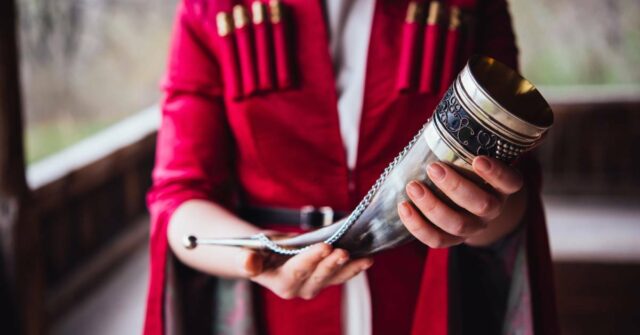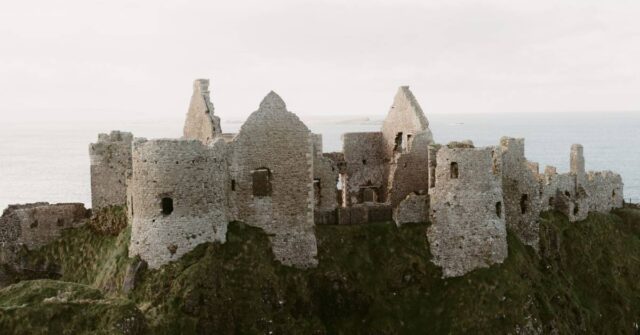Welcome to the royal table, where the glasses aren’t just containers but storied vessels of history and power.
Ever wondered what kings of yore sipped their vintage wine from or what adorned the banquet tables of the medieval courts?
Let’s embark on a regal journey through time to discover the drinkware that has quenched the thirst of monarchs.
The Historical Context of Royal Drinkware
Tracing back to ancient civilizations, the choice of drinkware was more than a matter of taste—it was a statement of authority and wealth.
From the clay cups of the Pharaohs to the bejeweled goblets of the Renaissance, each era had its hallmark.
Ancient Civilizations and Royal Cups
In the sands of Egypt and the ruins of Mesopotamia, archaeologists have unearthed cups made of gold and silver, signifying the drinkware of the gods and their earthly counterparts, the kings.
These cups were often simple in form but rich in symbolism.

Medieval Times: From Goblets to Chalices
The medieval period saw the rise of the goblet, a sturdy vessel, often made of metal and sometimes adorned with precious stones.
The chalice, with its deep religious significance, was reserved for the most sacred of liquids—wine transformed into the blood of Christ during the Eucharist.
The Renaissance and the Age of Exploration
As Europe emerged from the Dark Ages, the Renaissance breathed life into art and drinkware alike.
Intricately designed glassware became the norm in royal courts, reflecting the era’s appreciation for beauty and craftsmanship.
Modern Monarchies: Tradition and Change
Fast forward to today, and while the materials may have evolved, the essence of regal drinkware remains.
Crystal and fine porcelain now grace the tables of modern monarchs, blending tradition with contemporary elegance.
Materials and Craftsmanship
The transition from stone and wood to metals and glass tells not just a story of technological advancement but of the shifting sands of taste and power dynamics within royal courts.
Gold and Silver: Symbols of Wealth and Power
Gold and silver, materials that do not tarnish, were the metals of choice for royal drinkware, symbolizing the eternal nature of their rule.
These metals were worked with incredible skill to create pieces that were both functional and decorative.
Precious Stones and Inlays: The Pursuit of Beauty
To further elevate their status, kings would commission drinkware inlaid with precious stones.
Rubies, sapphires, and emeralds not only added color and life to these objects but also conveyed the wealth and power of their owners.
Crystal and Glass: Clarity and Brilliance
The invention of crystal glass brought a new dimension to royal drinkware. Its clarity and brilliance allowed for the design of pieces that played with light, adding a magical ambiance to royal feasts.
Exotic Materials: A Show of Global Influence
As empires expanded, kings sought to impress with drinkware made from exotic materials. Ivory, rhinoceros horn, and even turtle shells became symbols of the reach and influence of a kingdom.
Drinking Horns: A Toast to Tradition
Long before the refinement of glass and crystal, drinking horns were the vessel of choice among many early civilizations, including the Vikings and Celts.
These horns, often taken from cattle or large game, were not merely containers for ale or mead; they were symbols of status, strength, and fellowship.

Each horn was unique, adorned with metalwork, carvings, and sometimes precious stones, to reflect the power and prestige of its owner.
Kings and chieftains would raise these horns in toasts that sealed pacts and celebrated victories, imbuing them with ceremonial importance that echoed through the ages.
The drinking horn reminds us of humanity’s deep connection to nature and the animal kingdom, serving as a testament to the resourcefulness and artistry of ancient cultures in crafting royal regalia from the bounty of the earth.
Design and Symbolism
The design of royal drinkware was never accidental. Every curve, emblem, and inscription told a story, conveyed a message, or invoked a deity’s protection.
The Evolution of Shapes and Sizes
From the stout cups of the ancients to the slender flutes of the modern era, the evolution of drinkware shapes reflects changing tastes and the types of beverages favored by royalty over the centuries.
Symbolic Imagery and Inscriptions
Royal drinkware often bore the coat of arms or the personal emblem of the monarch, turning each piece into a personal statement and a piece of propaganda, proclaiming the king’s right to rule.
Customization for the King
Custom-made to suit the preferences of each monarch, these pieces were the ultimate luxury, from the material to the craftsmanship. This level of customization meant that no two pieces were exactly alike.
Rituals and Ceremonies
Drinkware wasn’t just about drinking; it played a crucial role in rituals and ceremonies, symbolizing unity, allegiance, and divine favor.
The Role of Drinkware in Royal Ceremonies
In coronations and weddings, drinkware was more than vessels; they were symbols of unity and continuity.
A chalice might be passed around to symbolize the shared destiny of the royal court, while in some cultures, a new king would drink from a special cup to symbolize his connection to the divine.
Gifts and Diplomacy: Drinkware as a Political Tool
Royal drinkware also served as a tool of diplomacy. Exquisitely crafted pieces were often presented as gifts to foreign dignitaries, symbolizing peace, friendship, or allegiance between nations.
The message was clear: the wealth and sophistication of the gifting nation.
Preservation and Display
The transition of royal drinkware from daily use to museum artifacts marks the end of one era and the beginning of another, where these items serve as a window into the past.
From Use to Museum Pieces
Many pieces of royal drinkware have made their way into museums around the world, where they are preserved and displayed.
These artifacts offer insights into the culture, technology, and aesthetics of their time, telling the untold stories of past monarchies.

The Role of Replicas in Understanding History
Replicas play a crucial role in bringing the history of royal drinkware to life for those who can’t access the originals.
Through careful reproduction, the beauty and significance of these pieces remain accessible to all, allowing a broader appreciation of our shared history.
Interesting Anecdotes and Facts
Every cup, goblet, and chalice has a story, some more colorful and surprising than others, revealing the human side of the kings who used them.
Famous Kings and Their Preferred Drinkware
Did you know that Henry VIII had a favorite wine goblet, so beloved that it accompanied him on his travels?
Or that Emperor Nero drank solely from a cup made of a rare mineral, believing it would protect him from poison?
Lost and Found: The Stories of Rediscovered Royal Cups
Tales of royal drinkware lost to the sands of time and then miraculously rediscovered can rival any adventure story.
The discovery of such pieces often opens new chapters in our understanding of history, offering insights into long-gone civilizations.

Comparative Perspectives
Examining the differences and similarities in royal drinkware across cultures reveals much about the universality and diversity of human civilization.
East vs. West: Differing Traditions in Drinkware
While Western kings favored goblets and chalices, Eastern monarchs often preferred intricately designed tea and sake sets, reflecting the distinct ceremonial and social roles of drinkware in different cultures.
Royal Drinkware vs. Common Folk: A Contrast
The stark differences between the ornate drinkware of royalty and the simple, utilitarian vessels of the common folk underscore the social hierarchies and economic disparities of past societies.
Modern Interpretations and Inspirations
Today, royal drinkware continues to inspire artists, designers, and craftsmen, blending historical motifs with contemporary aesthetics.
Replicas and Souvenirs: Royal Drinkware in Popular Culture
Replicas of famous royal drinkware have become popular souvenirs, allowing everyone a piece of history.
These reproductions, whether of ancient goblets or modern crystal flutes, bridge the gap between past and present, making history tangible and relatable.
Contemporary Craftsmen and Their Royal-Inspired Creations
Modern craftsmen draw inspiration from historical drinkware, creating pieces that echo the past while fitting seamlessly into today’s world.
These items blend the allure of royalty with the practicalities of modern life, making every sip a nod to history.

Conclusion: The Legacy of Royal Drinkware
The journey through the world of royal drinkware is more than a peek into the past; it’s a reflection on the power, culture, and artistry that shaped human history.
These vessels, more than mere containers for drink, are treasures that carry the legacy of those who once held them.
As we raise our glasses today, let’s toast to the kings and queens of yore, whose stories of splendor and simplicity continue to fascinate and inspire us.
So, next time you lift a glass, remember that you’re partaking in a tradition as old as civilization itself, a small act connecting you to the great tapestry of human history. Cheers to that!











